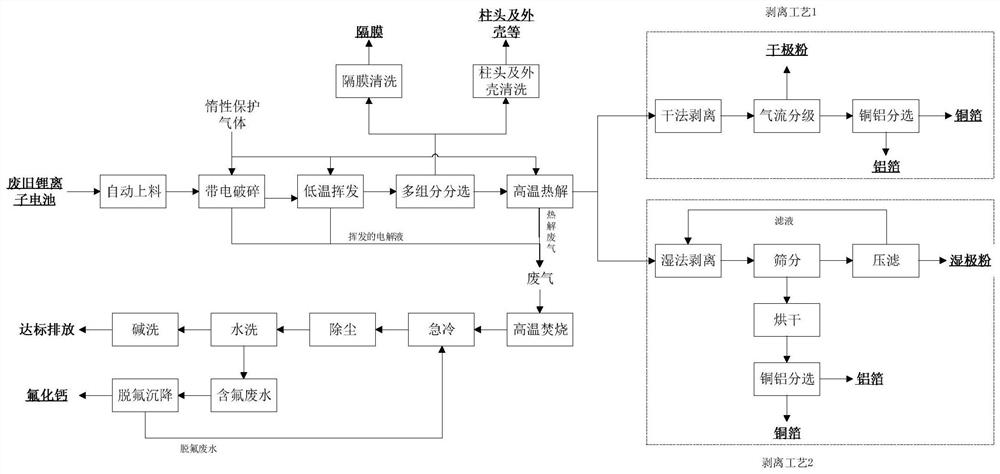Method for recycling all components of waste lithium battery
A waste lithium battery, full component technology, applied in battery recycling, recycling technology, recycling by waste collectors, etc., can solve the problem of long discharge cycle, recovery rate of electrode powder, low grade, strong electrolyte smell, etc. in the salt water discharge process problems, to achieve the effect of improving the recovery rate of the powder, improving the recovery rate and grade, and large particle size
- Summary
- Abstract
- Description
- Claims
- Application Information
AI Technical Summary
Problems solved by technology
Method used
Image
Examples
Embodiment 1
[0029] 1) Transport the scrap lithium iron phosphate battery to the crusher through the automatic feeding device.
[0030] 2) In a shear crusher with a sealed cavity and filled with nitrogen protection, the charged scrap lithium iron phosphate battery is sheared and crushed once, and the particle size of the crushed material is 30mm.
[0031] 3) The crushed material directly enters the low-temperature volatilization furnace to volatilize the electrolyte, and volatilizes in a sealed converter filled with nitrogen protection. The volatilization time is 1 hour and the volatilization temperature is 120°C.
[0032] 4) Use a vibrating screen to screen the fine-grained materials from the products after low-temperature volatilization, and then use a vertical winnowing machine to select the light product diaphragm, positive and negative electrode sheets, heavy product casing, and pile head.
[0033] 5) The septum, casing, and stigma sorted out in step 4) are cleaned by a cleaning devic...
Embodiment 2
[0040] Use the feeding, crushing, low-temperature volatilization, multi-component sorting, and pyrolysis procedures in Example 1 to process the waste lithium iron phosphate battery cells, and the obtained positive and negative electrodes are stripped by wet method, and the mass fraction is 0.5%. Soak in dilute sulfuric acid for 5 minutes, then sieve through a vibrating sieve and wash with high-pressure water. The slurry under the sieve is filtered through a filter press to obtain wet pole powder, and the filtrate is returned for reuse. The post-drying treatment process of the oversize is the same as in Example 1.
[0041] The grade of the final electrode powder obtained is 98%, and the recovery rate is 98%; the grade of copper foil and aluminum foil is 99%, and the recovery rate is 97%; the grade of the shell and column head is 99%, and the recovery rate is 96%.
Embodiment 3
[0043] Using the process in Example 1 to process waste ternary lithium-ion battery monomers, the grade of the finally obtained pole powder is 96%, and the recovery rate is 96%; the grade of copper foil and aluminum foil is 99%, and the recovery rate is 96%; the grade of the shell and the column head is 99%. %, the recovery rate is 96%.
PUM
| Property | Measurement | Unit |
|---|---|---|
| recovery rate | aaaaa | aaaaa |
Abstract
Description
Claims
Application Information
 Login to View More
Login to View More - R&D
- Intellectual Property
- Life Sciences
- Materials
- Tech Scout
- Unparalleled Data Quality
- Higher Quality Content
- 60% Fewer Hallucinations
Browse by: Latest US Patents, China's latest patents, Technical Efficacy Thesaurus, Application Domain, Technology Topic, Popular Technical Reports.
© 2025 PatSnap. All rights reserved.Legal|Privacy policy|Modern Slavery Act Transparency Statement|Sitemap|About US| Contact US: help@patsnap.com

